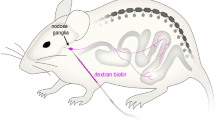Abstract
Using in situ hybridization techniques with an RNA probe coding for approximately 3.5 repeats of ubiquitin, corresponding to the polyubiquitin genes, we were able to demonstrate that under normal conditions the expression of the ubiquitin genes predominates specially in regions CA1, CA2 and CA3 of the hippocampus, in the dentate gyrus and in Purkinje cells of the cerebellum, being less prominent in neuronal cell bodies of the cerebral cortex. When the animals were submitted to an acute oxidative stress by injection of Fe/Dextran, the hybridization signal was apparently increased in the above mentioned regions of the hippocampus and in the cerebral cortex. On the other hand, the animals chronically injected with Fe/Dextran showed a highly intense gene expression in the cerebral cortex and in the cerebellum, particularly in the granular cell layer of this structure. The hybridization signal of the transcripts was absent in the Purkinje cells. The results suggest that the expression of the ubiquitin genes by CNS neurons depends on the anatomical location of the cells and that it increases as a consequence of the oxidative stress conditions to which they are submitted.
Similar content being viewed by others
REFERENCES
Ozkaynak, E., Finley, D., and Varshavsky, A. 1984. The yeast ubiquitin gene: Head-to-tail repeats encoding a polyubiquitin precursor protein. Nature 312:663–666.
Wiborg, O., Pedersen, M. S., Wind, A., Berglund, L. E., Marcker, K. A., and Vuust, J. 1985. The human ubiquitin multigene family: Some genes contain multiple directly repeated ubiquitin coding sequences. EMBO J. 4:755–759.
Rechsteiner, M. 1987. Ubiquitin-mediated pathways for intracellular proteolysis. Ann. Rev. Cell Biol. 3:1–30.
Adamo, A. M., Besio Moreno, M., Soto, E. F., and Pasquini, J. M. 1994. Ubiquitin-Protein conjugates in different structures of the Central Nervous System of the rat. J. Neurosci. Res. 38:358–364.
Ozkaynak, E., Finley, D., Solomon, M. J., and Varshavsky, A. 1987. The yeast ubiquitin genes: a family of natural gene fusions. EMBO J. 6:1429–1439.
Monia, B. P., Ecker, D. J., and Crooke, S. T. 1990. New perspectives on the structure and function of ubiquitin. Bio/technology 8:209–215.
Tan, Y., Bishoff, S., and Riley, M. 1993. Ubiquitins revisited: Further examples of within-and between-locus concerted evolution. Mol. Phylogenet. Evol. 2:351–360.
Finley, D., Bartel, B., and Varshavsky, A. 1989. The tails of ubiquitin precursors are ribosomal proteins whose fusion to ubiquitin facilitates ribosome biogenesis. Nature 338:394–401.
Redman, K. L., and Rechsteiner, M. 1989. Identification of the long ubiquitin extension as ribosomal protein S27 a. Nature 338:438–440.
Finley, D., Ozkaynak, E., and Varshavsky, A. 1987. The yeast polyubiquitin gene is essential for resistance to high temperatures, starvation and other stresses. Cell 48:1035–1046.
Denhardt, D. T. 1966. A membrane filter technique for detection of complementary DNA. Biochem. Biophys. Res. Commun. 23:641–646.
Ciechanover, A., and Schwartz, A. L. 1994. The ubiquitin-mediated proteolytic pathway: mechanisms of recognition of the proteolytic substrate and involvement in the degradation of native cellular proteins. FASEB J. 8:182–191.
Rechsteiner, M. 1991. Natural substrates of the ubiquitin proteolytic pathway. Cell 66:615–618.
Varshavsky, A. 1992. The N-End rule. Cell 69:725–735.
Adamo, A. M., and Pasquini, J. M. 1995. Ubiquitin-protein conjugate formation during degradation of CNS oxidized proteins. J. Neurochem. 64Suppl. S71D.
Finley, D., Ciechanover, A., and Varshavsky, A. 1984. Thermolability of ubiquitin-activating enzyme from the mammalian cell cycle mutant ts85. Cell 37:43–55.
Fraser, J., Luu, H. A., Neculcea, J., Thomas, D. Y., and Storms, R. K. 1991. Ubiquitin gene expression: response to environmental changes. Curr. Genet. 20:17–23.
Youdim, M. B. H. ed. 1988. Brain Iron: Neurochemical and Behavioral Aspects. Taylor and Francis, London.
Roskams, A. J. I., and Connor, J. R. 1992. Transferrin receptor expression in myelin deficient (md) rats. J. Neurosci. 31:421–427.
Hill, J. M., Ruff, M. R., Weber, R. J. and Pert, C. B. 1985. Transferrin receptors in rat brain: Neuropeptide-like pattern and relationship to iron distribution. Proc. Natl. Acad. Sci. USA. 82:4553–4557.
Pullen, R. G. L., Candy, J. M., Morris, C. M., Taylor, G., Keith, A. B., and Edwardson, J. A. 1990. Gallium-67 as a potential marker for aluminum transport in rat brain: implications for Alzheimer's disease. J. Neurochem. 55:251–259.
Mash, D. C., Pablo, J., Flynn, D. D., Efange, S. M. N., and Weiner, W. J. 1990. Characterization and distribution of transferrin receptors in the rat brain. J. Neurochem. 55:1972–1979.
Noga, M., and Hayashi, T. 1996. Ubiquitin gene expression following transient forebrain ischemia. Mol. Brain Res. 36:261–267.
Author information
Authors and Affiliations
Rights and permissions
About this article
Cite this article
Adamo, A.M., Besio Moreno, M.A., Carrasco, A. et al. Expression of the Ubiquitin Genes in Brain of Normal and Fe/Dextran Injected Rats. Neurochem Res 22, 345–350 (1997). https://doi.org/10.1023/A:1027335021812
Issue Date:
DOI: https://doi.org/10.1023/A:1027335021812




